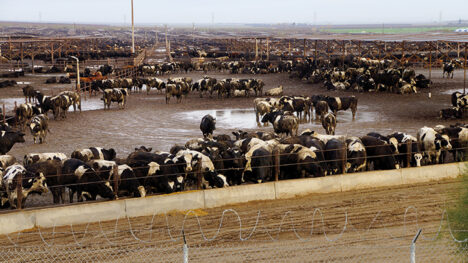A View Through the Curtain
June 1, 2006
The time was coming closer and he had mixed feelings of excitement and apprehension.
You could call it “holy” fear. In a few moments he would enter the Holy of Holies—the innermost part of the Herod’s Temple. He was the high priest, and the only one allowed to enter that part of God’s sanctuary on earth, and that only once a year, there to make atonement for the sins of his people.
He had to prepare himself and make atonement with a clear conscience and a humble heart.
Was he to enter the innermost part with presumption and without firstly cleansing himself, both outwardly and inwardly, then he would be struck dead. That is why he had a rope tied around his ankle; so he could be pulled back out by his fellow priests should he be struck dead by God! Once inside, he could begin the ceremony, as ordained by God through Moses.
The Holy of Holies was the innermost part of the temple of God. In this inner place Jehovah manifested Himself on the ark of the covenant. The design of the Temple, down to the details of the materials to be used, was given to Moses directly by God. The Holy of Holies was separated from the holy place, or first compartment of the inner temple, by a curtain or veil. The curtain was made of blue, purple and scarlet, fine-twined linen, embroidered with cherubim. The colour purple was the colour of royalty, while scarlet was the colour of blood.
The curtain had a threefold symbolic purpose. First, it was there as a symbol of separation; to make people aware that there was a separation, a dividing gulf between themselves (human beings infected by sin) and God (holy and perfectly pure). No sinful human being can stand in the presence of God and live.
The holiness of God would consume us instantly. Just like a drop of water that finds itself in the presence of fire instantly evaporates, so would we. The curtain was there to prevent people from inadvertently seeing the glory of God and dying on the spot.
The second purpose of the curtain was to make the people aware they needed a mediator to bridge that dividing gulf between themselves and God, their creator.
This gulf could be overcome only through a mediator who would intercede for them. People could not approach the holy presence of God themselves and receive forgiveness. Only the high priest could do that for them.
The third purpose of the curtain was to show that their separation from God was complete. The curtain had to cover the entrance completely so nothing that was in the inner room could be seen from the outer room.
The curtain was a covering that was spread over and completely covered the entrance to the innermost room of the temple.
The Greek word for curtain ( katapetasma ) can be found in the Gospels and in the book of Hebrews. When it first appears in the Gospels, it is associated with the most pivotal event in human history, Christ’s crucifixion. The curtain of the Temple in Jerusalem was destroyed when Jesus died on the cross, an incident described in Matthew 27:50-52: “And when Jesus had cried out again in a loud voice, he gave up his spirit. At that moment the curtain of the temple was torn in two from top to bottom.The earth shook and the rocks split.The tombs broke open and the bodies of many holy people who had died were raised to life.”
The tearing of the curtain was a significant event and that is why it was recorded in the Gospels. It had a number of messages for the people of Israel back then and for all humanity from then onwards.
Together with the other miraculous events that occurred at the time of Jesus’ death, it demonstrated that the kingship of Jesus was greater than human rule, human authority and human power. It demonstrated that the earthly temple system was not capable of providing the final solution to the cleansing of a sinner. The book of Hebrews confirms this: “The law is only a shadow of the good things that are coming—not the realities themselves. For this reason it can never, by the same sacrifices repeated endlessly year after year, make perfect those who draw near to worship.… It is impossible for the blood of bulls and goats to take away sins” (Hebrews 10:1-4).
The final solution to the problem of cleansing from sin could be provided only by the sacrifice of the Son of God.
Therefore the tearing of the curtain symbolised the demise of the old order of things and the institution of a new order, the new covenant.
The tearing of the curtain also had messages that related to the three symbolic applications of the Temple curtain.
First, the symbol of separation was destroyed. The way to the presence of God was now open. Our sins that were separating us from God have now been covered with the blood of Christ. Instead of the glory of God being covered by the veil, we are now covered with the robe of Christ’s perfect life and atoning death.
Through the sacrifice of God’s own Son on the cross, the sinner can now approach God.
Again the book of Hebrews is clear: “Let us then approach the throne of grace with confidence, so that we may receive mercy and find grace to help us in our time of need” (Hebrews 4:16). Jesus told His disciples to ask in His name.
He said, “I am not saying that I will ask the Father on your behalf. No, the Father himself loves you because you have loved me and have believed that I came from God” (John 16:26, 27).
The disciples could now come to the Father directly, but always in the name of Christ, and place their requests. That could now happen because they would accept Christ’s forgiveness and grace and their hearts would be changed. They had met Christ, and his love and power had transformed the core of their being. The sacrifice of Jesus on the cross for our forgiveness and his subsequent resurrection are the events that can change our hearts too so we can have a clear and open communication line with the Father.
Second, the tearing of the curtain symbolised that there was no longer a need for a human mediator. Christ has now become our mediator. Again, the Word of God confirms that “there is one God and one mediator between God and men, the man Christ Jesus” (1 Timothy 2:5).
Jesus lives forever and is even now interceding for us. “He is able to save completely those who come to God through Him, because He always lives to intercede for them” (Hebrews 7:25). That is His role at the present time until He returns to this earth for the second time to claim His people. And it is not simply a “role” but a ministry He carries out with deep desire and passion.
And, finally, the entrance to the Holy of Holies was covered with the curtain completely. Going through the curtain was the only way to gain access to God’s presence. The third meaning of the tearing of the curtain is that the only way to gain access to God now is through the torn body of Christ. “Since we have confidence to enter the Most Holy Place by the blood of Jesus, by a new and living way opened for us through the curtain, that is, his body … let us draw near to God with a sincere heart in full assurance of faith” (Hebrews 10:21, 22).
“There is no other name under heaven given to men by which we must be saved” (Acts 4:12).
There’s a traditional Negro spiritual song that says, “He’s so high, you can’t get over Him; He’s so low, you can’t get under Him; He’s so wide, that you can’t get around Him, you must come in by and through the Lamb.” There is no longer a need for a curtain to hide God’s glory because it has been revealed to humanity in a way that would not consume us on sight. God has revealed His glory in the life, death and resurrection of His Son, Jesus Christ.
For me, as for anyone who wishes it for themselves, it’s a privilege to be able to approach the living God in prayer and to find mercy, forgiveness and grace, and joy and peace in His presence. I’m thankful there’s no longer a curtain between us.









